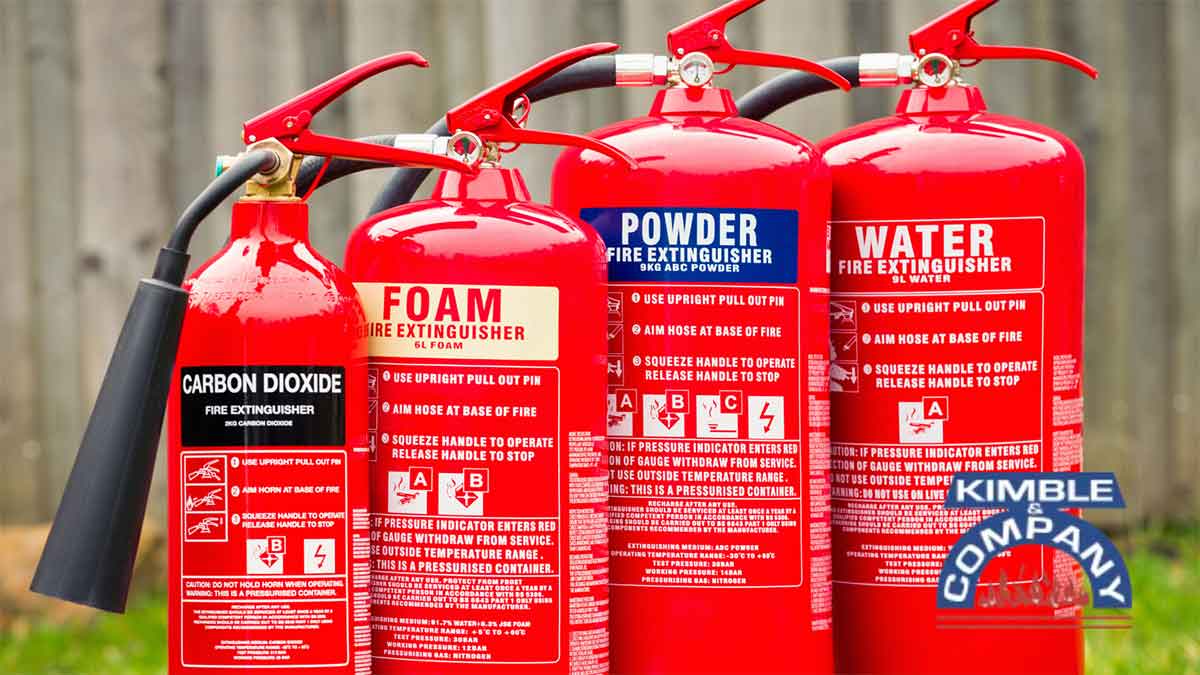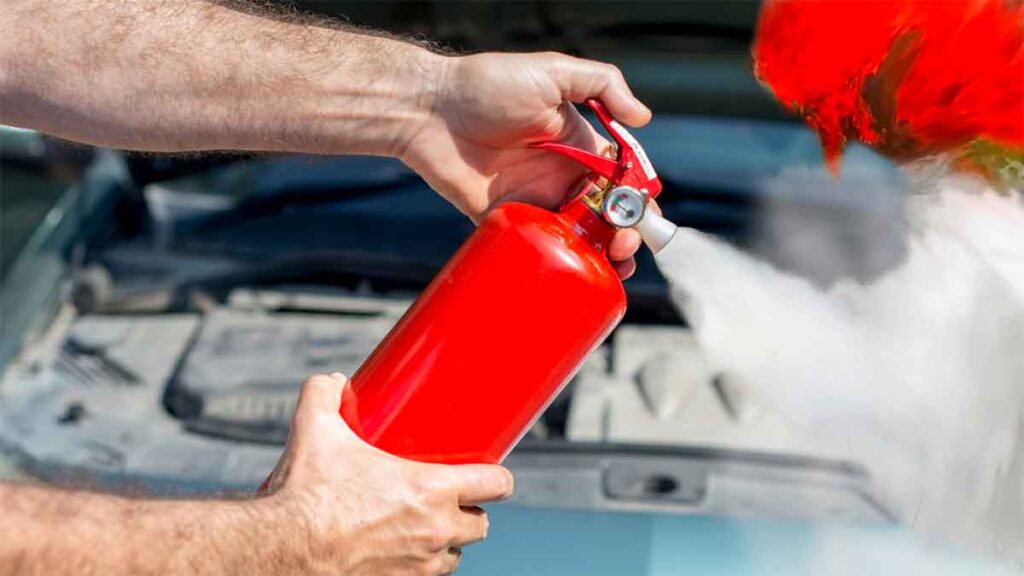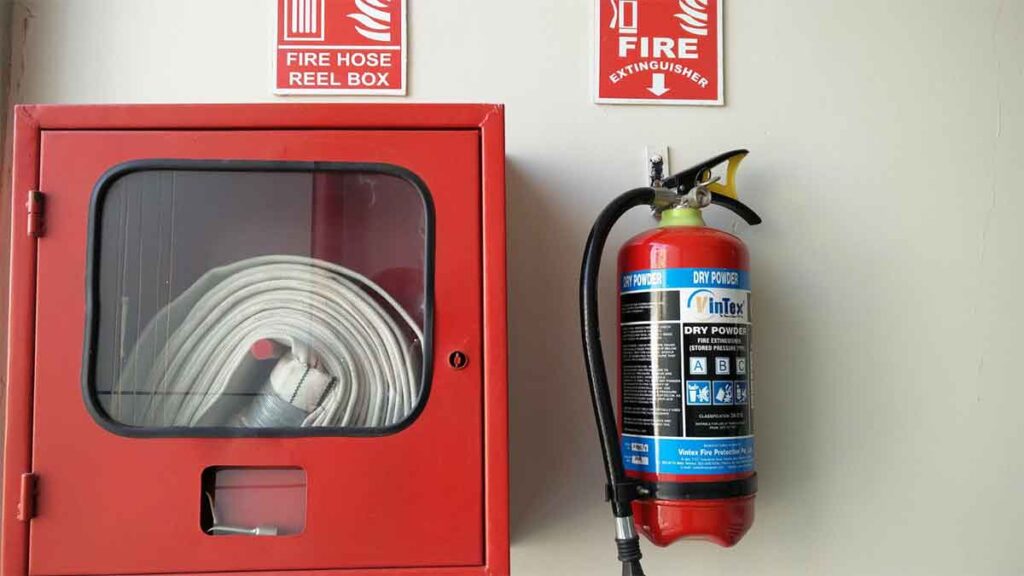When a fire breaks out, quick action is critical. Having a fire extinguisher nearby can mean stopping the flames before they spread, but not every extinguisher works for every type of fire. Choosing the wrong one can make the situation worse, which is why so many people hesitate in those first crucial seconds.
Fire safety starts long before an emergency. Installing fire alarm systems alerts you to danger, but knowing which extinguisher to use gives you the power to act immediately. Each extinguisher works in a particular way, making the right match essential to stop it.
To give you proper guidance, we’ll walk you through what the 5 types of extinguishers are and what each is used for. By connecting the right equipment to the right situation, you can respond faster, stay safer, and prevent a small fire from becoming something much bigger.
What Are Fire Extinguishers and How Do They Work
Fire extinguishers are compact but powerful safety tools. Inside each is a pressurized firefighting agent designed to cool flames, remove oxygen, or interrupt the chemical process that keeps a fire burning. The type of agent depends on the extinguisher’s intended use, which is why they’re labeled for specific fire classes.
To provide further context, here’s how most fire extinguishers work:
- Pull the safety pin to unlock the handle and prepare the extinguisher for use.
- Aim the nozzle at the base of the flames, not the smoke or higher flames.
- Squeeze the handle to release the pressurized agent.
- Sweep side to side across the base until the fire is fully out.
- Check the area to be sure the fire does not reignite.
Choosing the proper extinguisher for the correct type of fire is what makes this process effective. Using water on an electrical or grease fire can cause serious harm. That’s why knowing how extinguishers work matters as much as knowing which one to grab.
Quick action with the correct extinguisher saves lives and property.
Why Different Types of Fire Extinguishers Are Necessary
Fires are not all the same. The way a fire burns depends on the fuel feeding it, and that determines how it should be put out. A fire in a paper-filled office behaves very differently from one caused by a grease spill in a commercial kitchen.
Different extinguishers are designed with agents that target specific hazards. Water, foam, dry chemicals, CO₂, and wet chemicals all have distinct properties that make them effective for certain fire types. This is why workplaces, public buildings, and homes often have more than one type of extinguisher. It ensures a fast and effective response regardless of the fire’s cause.
Key reasons for having multiple extinguisher types include:
- Fires are classified by their fuel source, and each class needs a specific extinguishing method.
- Certain extinguishers can be dangerous if used on the wrong fire type.
- Some environments, like kitchens or labs, have unique fire risks.
- Proper extinguisher selection reduces the chance of injury during use.
- Having the proper extinguisher available is part of meeting safety codes and regulations.
Matching the extinguisher to the fire type is not just good practice; more than anything, it is critical for safety. Many real-world examples of successful fire safety practices include quick responses made possible by having the correct extinguisher in the right location.
This simple but vital step prevents damage, reduces risk to people, and supports faster recovery after an incident.
The Five Types of Fire Extinguishers and Their Specific Applications
Each fire extinguisher type is designed for specific fire classes, based on the fuel involved. Knowing which extinguisher to use ensures the fire is suppressed quickly and safely. Let’s look at the five main types of extinguishers and where each one is most effective.
Class A Fire Extinguishers for Ordinary Combustible Materials
Class A extinguishers are designed for fires involving everyday combustible materials such as paper, wood, cloth, and some plastics. These materials burn with an ember and can be extinguished effectively by cooling them with water or water-based agents.
The most common Class A extinguisher uses water or a foam mixture to lower the temperature of the burning material. This stops the combustion process and prevents the fire from reigniting. They are frequently found in offices, schools, and residential spaces where these materials are abundant.
Class A extinguishers are not suitable for flammable liquids, electrical fires, or metal fires. Using them outside their intended scope can create safety hazards or make the fire spread.
Class B Fire Extinguishers for Flammable Liquids and Gases
Class B extinguishers are made for fires fueled by flammable liquids like gasoline, oil, grease, and solvents, as well as gases like propane. These fires spread quickly and cannot be safely extinguished with water.
These extinguishers typically contain foam, CO₂, or dry chemical agents. The agents work by smothering the fire and cutting off its oxygen supply, effectively stopping combustion. They are often used in workshops, garages, gas stations, and industrial sites where such fuels are present.
It’s essential to handle Class B fires with care, as liquid fuel can easily splash or vaporize, creating a greater hazard. Using the correct extinguisher reduces the risk of flare-ups during suppression.
Class C Fire Extinguishers for Electrical Equipment Fires
Class C extinguishers are intended for fires involving energized electrical equipment such as appliances, wiring, circuit breakers, and servers. These fires require a non-conductive extinguishing agent to protect the user from electrical shock.
The most common agents for Class C extinguishers are CO₂ and dry chemicals. They work by displacing oxygen or interrupting the chemical reaction without leaving conductive residue on the equipment. These extinguishers are essential in offices, data centers, and manufacturing facilities with heavy electrical use.
Once the power is disconnected, the fire may shift to a different class depending on the fuel involved. At that point, another extinguisher type may be required to put out the fire entirely.
Class D Fire Extinguishers for Combustible Metals
Class D extinguishers are specialized for fires fueled by combustible metals such as magnesium, titanium, sodium, and potassium. These metals can burn at extremely high temperatures and react violently with water or common extinguishing agents.
These extinguishers use dry powders designed to smother the fire and absorb heat. The powder forms a crust over the burning metal, isolating it from oxygen and preventing further reaction. Class D units are primarily found in laboratories, metal workshops, and manufacturing plants that work with reactive metals.
Using the proper extinguisher here is critical for safety and aligns with best practices for fire prevention in industrial environments. Attempting to fight a metal fire with the wrong agent can lead to explosions or dangerous chemical reactions.
Class K Fire Extinguishers for Cooking Oils and Fats
Class K extinguishers are designed for commercial kitchens and food preparation areas where cooking oils, animal fats, and grease fires are common. These fires burn at very high temperatures and can reignite quickly if not handled correctly.
These extinguishers use a wet chemical agent that reacts with the oil or fat through a process called saponification. This reaction forms a thick, soap-like layer on the surface, cooling the fire and sealing out oxygen. This method is highly effective in preventing re-flash.
Class K extinguishers are standard in restaurants, cafeterias, and catering facilities. Even in home kitchens with deep fryers, having one nearby can significantly improve fire safety.
Key Summary
Fire extinguishers are essential tools for controlling small fires before they spread. Understanding the different classes ensures you choose the right one for the job and use it safely. Each extinguisher type is designed for a specific fuel source, and knowing the difference can prevent accidents and save lives.
Having the correct extinguisher is just one part of a strong safety plan. Pairing them with proper training, regular maintenance, and reliable fire protection services ensures they work when needed. This combination of knowledge and preparation reduces risk and improves response times during emergencies.
By learning how each of the five extinguisher types works and where to use them, you can protect people, property, and operations more effectively. Fire safety is about readiness, and making the right choice in seconds can change the outcome of an entire situation.



